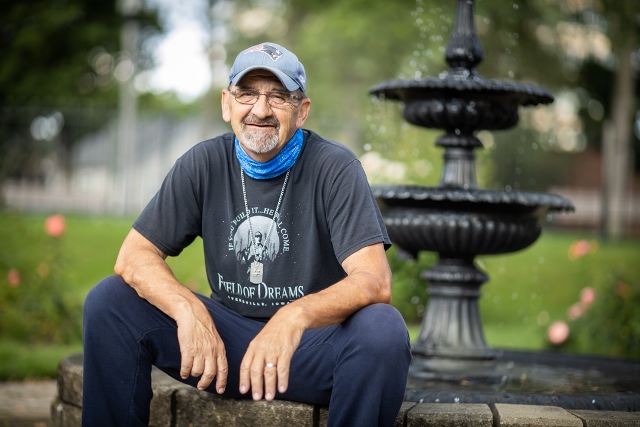It was 10:30 at night when Ernst Seeger realized he needed immediate medical attention. The Niagara Falls man was at home recovering from bladder cancer surgery and started experiencing intense, escalating abdominal pain.
But instead of going to the hospital emergency department, Seeger, 64, reached out to his virtual healthcare team at Hamilton Health Sciences (HHS) using a tablet computer provided by the hospital as part of a study on virtual care for patients recovering at home after surgery.
“I apologized for contacting them so late but the nurse I spoke to said, `I’m glad you called. That’s what we’re here for.’”
While at the HHS Juravinski Cancer Centre having surgery for bladder cancer in May, Seeger was invited to take part in a national study to test virtual care and remote monitoring technology once he was discharged. The study — called post-discharge after surgery using virtual care with remote automated monitoring (or PVC-RAM) and administered by the Population Health Research Institute (PHRI) at Hamilton Health Sciences — was launched in response to challenges that hospitals were facing due to COVID-19. When restrictions came into place in early March due to the pandemic, hospitals like HHS began looking for ways to drastically reduce non-emergency care. Patients were sent home earlier after surgery where possible, and many in-hospital appointments were replaced with virtual visits. These virtual care visits help address serious complications that might otherwise lead to emergency department visits or readmissions.
Investing in research and technology is part of HHS’ vision to transform the way health care is provided, says Dr. Ted Scott, Vice President of Research and Chief Innovation Officer for HHS. “It’s about delivering a more patient-centred and seamless healthcare system and using virtual care and remote technology to allow patients to recover at home and if possible, avoid hospital re-admission,” says Scott.
When COVID-19 struck in early March, the technological revolution was already underway at HHS. The hospital simply shifted its efforts into an even higher gear in response to the pandemic. Hundreds of providers and health care staff pivoted to virtual care models in a matter of days, using phone and videoconferencing to continue providing access to speciality outpatient care for patients.
Since early April, HHS has experienced a 1,000 per cent increase in the use of virtual care with over 93,000 virtual visits between health care professionals and patients. HHS team members have engaged in more than 74,000 phone visits and approximately 19,000 video visits with patients.
In June, PHRI received funding through Roche Canada’s COVID-19 Innovation Challenge and the McMaster COVID 19 Research Fund for PVC-RAM. The trial recruited HHS patients (included in a total of 900 patients from participating hospitals across the country) who had undergone surgery for health issues including cancer, hip fractures and a ruptured abdominal aortic aneurysm. Patients received interactive remote symptom-monitoring technology called, which includes a tablet and equipment to assess their vitals — blood pressure, heart rate, respiratory rate, oxygen saturation, temperature and weight – at home.
HHS nurses run the central command centre in collaboration with perioperative physicians and use a tablet to virtually interact with patients. Patients can also be connected virtually to physicians. Patients use the remote monitoring technology to record their vital signs at home and information is sent in real-time to the nurses, who escalate care to physicians when medical assessment and intervention are required.
Previous post-operative research has demonstrated that while patients prefer to recover at home, the highest risk for complications is in the first month after surgery. Data shows that 15 to 20 per cent of post-operative patients will return for emergency treatment or hospitalization.
While patients are safest in the operating room or intensive care unit where they’re closely monitored by technology that will warn of problems and there’s a surgical team that can act quickly if needed, the COVID-19 pandemic has created new challenges for hospitals and care teams. In a quest to keep beds free and people out of the hospital, post-operative patients have been discharged from hospital earlier than would typically be the case. Virtual at-home monitoring technology is playing an instrumental role in helping people leave the OR and ICU sooner and safely recover at home.
Since the project launched in June, the PVC-RAM team has gathered many examples where virtual care helped address serious complications that might have otherwise led to emergency department visits or readmissions.
During his episode, Seeger spoke with a virtual-care nurse through video conferencing and used a tablet to send a photo of his surgical scar which appeared inflamed. The nurse consulted with a physician and Seeger was diagnosed with having an infection and prescribed medication.
“Our staff involved in this study have heard many stories where virtual care has helped address complications that would otherwise have meant a trip to the hospital. We are tracking these instances as part of the study. Prior to COVID-19, I could confidently say that HHS was in the midst of a technological revolution. But what felt revolutionary just a few weeks ago is beginning to feel remarkably normal. And for health care and patients, that’s a very good thing.”


